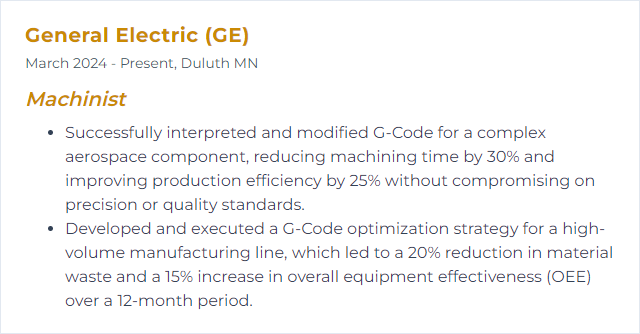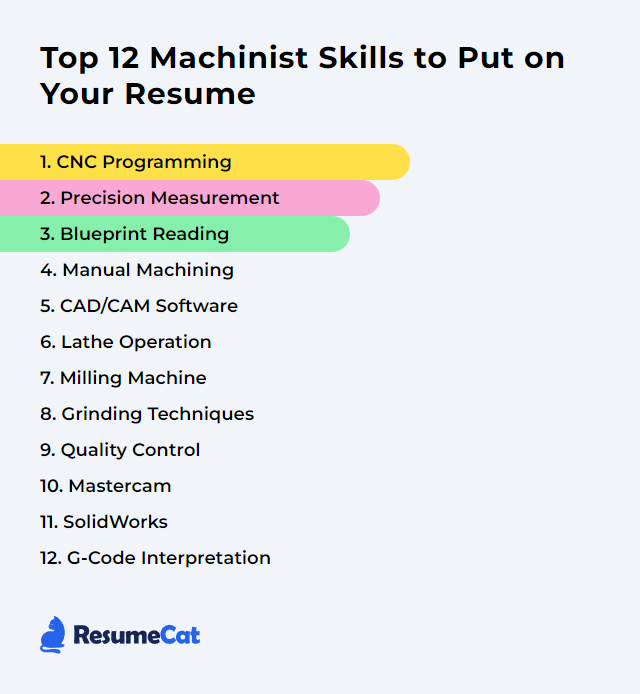Top 12 Machinist Skills to Put on Your Resume
In today's competitive job market, possessing a well-rounded set of skills is crucial for machinists aiming to stand out. This article highlights the top 12 machinist skills that are essential to showcase on your resume, helping you catch a hiring manager’s eye and stake your place in modern manufacturing.
Machinist Skills
- CNC Programming
- Precision Measurement
- Blueprint Reading
- Manual Machining
- CAD/CAM Software
- Lathe Operation
- Milling Machine
- Grinding Techniques
- Quality Control
- Mastercam
- SolidWorks
- G-Code Interpretation
1. CNC Programming
CNC programming is the craft of turning engineering intent into machine-ready instructions so a CNC can cut, shape, and form material into the right geometry. You translate designs into commands (often G-code and M-code) that machines execute with unblinking precision.
Why It's Important
CNC programming lets machinists control complex operations with accuracy and repeatability. Fewer mistakes. Faster cycles. Better parts. That’s how productivity climbs.
How to Improve CNC Programming Skills
Sharpening CNC programming blends fundamentals with feedback and iteration. Useful moves:
Nail the basics: Know your G-code/M-code cold, plus coordinate systems, work offsets, and canned cycles.
Simulate first: Run programs through verification tools to catch crashes, gouges, and wasted motion before the spindle spins. Fusion-style integrated CAD/CAM helps.
Keep learning: Explore advanced toolpaths, macros, subprograms, and parameterized code. Official training portals and vendor courses pay off.
Optimize toolpaths: Lean on high-efficiency strategies, arc filtering, and smoothing to reduce cycle time and tool wear.
Standardize: Build libraries for proven feeds/speeds, holders, tool numbers, and templates. Consistency saves hours.
Swap notes: Shop-floor collaboration and peer communities surface tricks you won’t find in manuals.
Manage tools: Keep a clean, current tool database with length/diameter offsets and life tracking.
Maintain machines: A tight, calibrated machine turns good code into good parts. Sloppy machines force ugly workarounds.
Write, test, refine. Then do it again. Progress comes fast when feedback is tight.
How to Display CNC Programming Skills on Your Resume
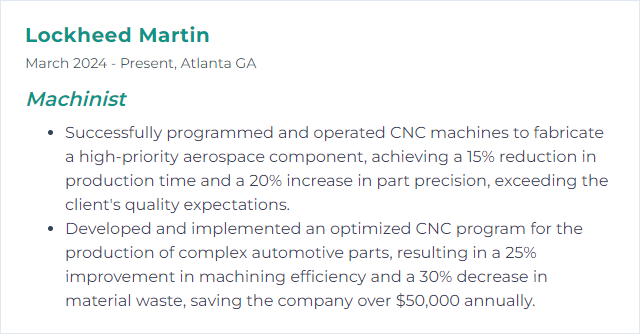
2. Precision Measurement
Precision measurement is the disciplined use of metrology tools—calipers, micrometers, height gages, CMMs—to hold tight tolerances and confirm parts meet spec. No guessing. Just numbers that line up.
Why It's Important
Parts must fit, seal, slide, and last. Accurate measurements prevent scrap, rework, and warranty headaches. Quality begins and ends with measurement.
How to Improve Precision Measurement Skills
Dial in your metrology by tightening process and environment:
Calibrate routinely: Establish intervals and traceability. Follow recognized calibration practices (NIST guidance and similar).
Use the right instrument: Match resolution and range to the job. Know when a bore gage beats a caliper, and when a CMM should settle the debate.
Control conditions: Temperature, humidity, vibration—stabilize them. Work to metrology-room habits where possible. Follow relevant ASME B89 metrology standards.
Standardize technique: Consistent force, clean surfaces, repeatable datum points. Process reduces variation.
Level up skills: Training from professional associations and trade shows keeps methods current.
Care for tools: Clean, inspect, and store instruments properly. Replace worn anvils and tips.
Use SPC: Track capability, spot drift, and intervene before parts go out of bounds.
Measure twice? More like measure right, every time.
How to Display Precision Measurement Skills on Your Resume
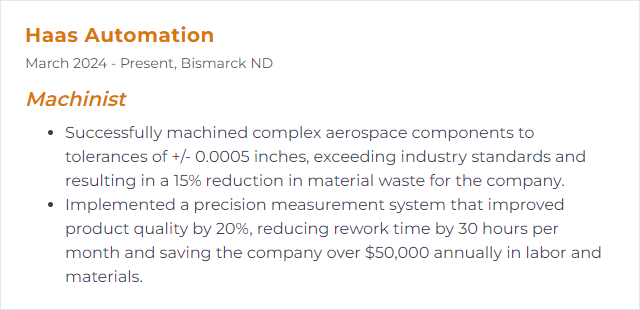
3. Blueprint Reading
Blueprint reading is the ability to interpret technical drawings—dimensions, notes, sections, finishes, materials, and the flow of features—so parts are made exactly as engineered.
Why It's Important
Without accurate print interpretation, even perfect machining won’t yield the right part. Clear understanding ensures proper features, tolerances, and function.
How to Improve Blueprint Reading Skills
Make prints feel fluent, not foreign:
Master symbols: Surface finishes, welds, threads, and standard callouts should be second nature.
Go deep on GD&T: Learn datums, feature control frames, and how tolerance zones truly constrain the part.
Practice with real drawings: Read, mark up, and back-check against finished parts. Repetition builds speed and accuracy.
Take structured courses: Blueprint reading and GD&T classes accelerate comprehension.
Use references: Books like “Blueprint Reading for Machinists” and recognized standards fill gaps fast.
Ask peers: Communities and shop reviews surface tricky conventions and tribal knowledge.
The print tells a story. Read it like a pro and the rest follows.
How to Display Blueprint Reading Skills on Your Resume

4. Manual Machining
Manual machining means running lathes, mills, and grinders by hand. You set up, you feel the cut, you listen to the tool. Direct control builds instinct you can’t fake.
Why It's Important
When fixtures are odd, quantities are tiny, or rework calls for finesse, manual skills shine. They also form the bedrock instincts that improve CNC results.
How to Improve Manual Machining Skills
Technique carries the day:
Chase precision: Use micrometers, indicators, and gauge blocks often. Tune your “feel.”
Know your materials: Steels, aluminums, exotics—all behave differently. Learn their quirks.
Own your tooling: Tool geometry, rake, relief, and coatings matter. Machinery’s Handbook is worth its weight.
Log lessons: Keep a build journal. What worked, what chattered, what finish you got at which feed.
Be relentless on safety: Guards, PPE, chip control, and discipline keep the work going.
Trade tips: Veteran machinists, shop forums, and local meetups will multiply your progress.
Take courses: Structured training—from community programs to open courseware—fills gaps fast.
Hands on. Eyes sharp. That’s the craft.
How to Display Manual Machining Skills on Your Resume

5. CAD/CAM Software
CAD/CAM tools let you design parts and generate the toolpaths that make them real. From sketch to solid, from fixture to post, you connect ideas to chips on the floor.
Why It's Important
CAD/CAM closes the gap between engineering and the machine. Quicker iterations, cleaner paths, tighter control—less scrap and more throughput.
How to Improve CAD/CAM Software Skills
Build skill, not just files:
Start with fundamentals: Sketching, constraints, assemblies, and manufacturing setups. Make them automatic.
Use built-in tutorials: Official training libraries from major platforms ramp you up efficiently.
Practice with real parts: Model legacy jobs, then program toolpaths and compare against shop results.
Simulate aggressively: Verify collisions, detect excess air time, and refine retracts and linking moves.
Master toolpath strategies: Adaptive clearing, HEM, rest machining, multi-axis finishing—choose wisely for each material and geometry.
Dial feeds and speeds: Use calculators, material libraries, and tool vendor data. Update your presets as you learn.
Own your post processors: Understand how posts map to your machines. Edit, test, and document.
Version and collaborate: Track revisions, keep CAM templates, and document setups for repeatability.
Stay current: New releases often improve toolpath engines and simulation. Update thoughtfully and note changes.
Design smarter, program cleaner, cut faster.
How to Display CAD/CAM Software Skills on Your Resume

6. Lathe Operation
Lathe operation centers on rotating work against a cutting tool to turn, face, bore, groove, and thread. Cylindrical perfection, one pass at a time.
Why It's Important
Lathes produce shafts, bushings, and threaded features with crisp tolerances. The backbone of countless assemblies.
How to Improve Lathe Operation Skills
Tune the machine, then the method:
Get the setup right: Level the machine, verify alignment, and inspect chucks, collets, and tailstock for runout.
Choose proper tooling: Match insert geometries, grades, and nose radii to material and operation. Keep edges sharp.
Optimize speeds/feeds: Use material-specific data and adjust for chatter, chip control, and tool life.
Apply coolant strategically: Improve surface finish and longevity with the right fluid and delivery.
Maintain religiously: Lubrication, wiper checks, way inspections, and backlash tracking prevent surprises.
Advance your technique: Learn threading nuances, parting tricks, and balancing overhang vs. rigidity.
Follow safety: No loose clothing, secure long stock, and keep chips under control.
A steady setup makes a steady part.
How to Display Lathe Operation Skills on Your Resume
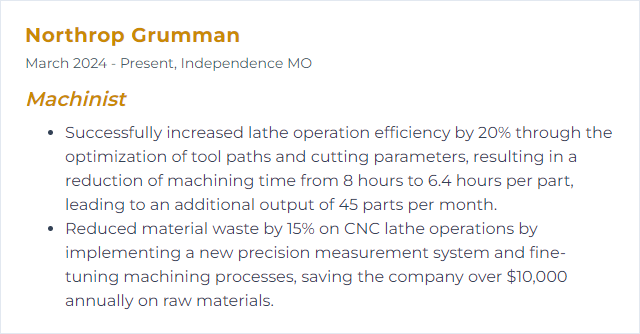
7. Milling Machine
A milling machine uses a rotating cutter to remove material from a stationary (or fixtured) part. Drilling, slotting, contouring—flat faces and complex curves all live here.
Why It's Important
Milling unlocks complex geometry with speed and accuracy, making precise components for everything from fixtures to aerospace assemblies.
How to Improve Milling Machine Skills
Boost accuracy and extend machine life:
Maintain consistently: Clear chips, lubricate ways, and inspect belts, gibs, and spindle bearings.
Upgrade cutting tools: Select appropriate substrates and coatings for your materials. Keep an organized tool library.
Use solid workholding: Vises, clamps, and dedicated fixtures should eliminate creep and vibration.
Tune speeds/feeds and stepovers: Balance MRR, finish, and tool life. Record what works.
Update CNC controls and posts: On CNC mills, keep software and parameters current for better motion control.
Increase rigidity: Shorten stickout, support tall setups, and reduce overhangs.
Apply coolant wisely: Flood, mist, through-spindle—choose a delivery that improves chip evacuation and finish.
Calibrate and tram: Check spindle tram, square vises, and verify axis alignment on a schedule.
Stability first. Precision follows.
How to Display Milling Machine Skills on Your Resume
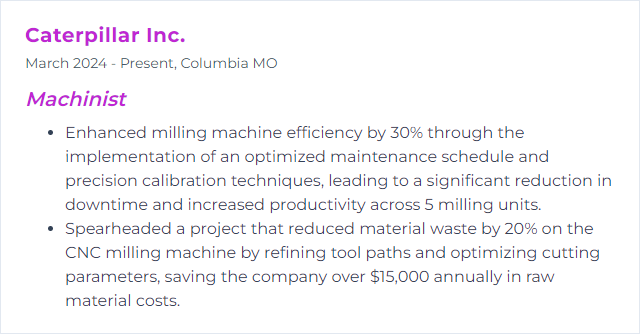
8. Grinding Techniques
Grinding uses abrasive wheels to achieve tight sizes and fine finishes. Surface, cylindrical, centerless—each method removes tiny amounts of material with surgical control.
Why It's Important
When tolerances shrink and finishes must gleam, grinding delivers. It’s the difference between good parts and flawless ones.
How to Improve Grinding Techniques Skills
Small tweaks make big differences:
Know your materials: Hardness, microstructure, and thermal behavior drive wheel choice and parameters.
Select proper abrasives: Match abrasive type, bond, structure, and grit to the job and finish.
Optimize parameters: Surface speed, infeed, crossfeed, and dwell—tune them, don’t guess.
Maintain the machine: Spindle health, slide condition, and vibration control are non-negotiable.
Use coolant effectively: Keep temperatures in check to avoid burns and preserve tolerances.
Dress and true: Keep wheels sharp and concentric. Dull wheels lie.
Work safely: Inspect wheels, ring test, guard properly, and respect RPM limits.
Precision lives in the microns. Treat it that way.
How to Display Grinding Techniques Skills on Your Resume
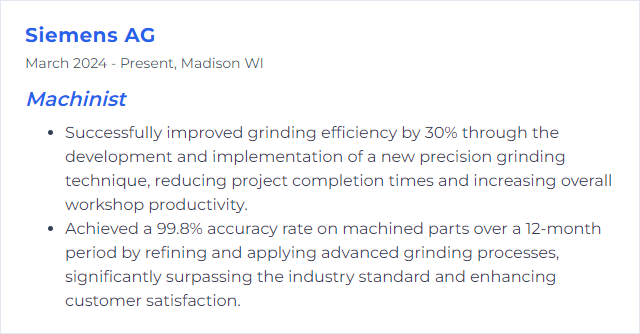
9. Quality Control
Quality Control ensures parts meet specification and function as intended. It’s process discipline plus verification at every stage.
Why It's Important
QC reduces scrap, protects customers, and keeps lines running. Confidence in every shipment, backed by data.
How to Improve Quality Control Skills
Build consistency, then improve it:
Standardize procedures: Clear work instructions, checklists, and change control reduce variation.
Calibrate instruments: Maintain a calibration program with traceability and documented intervals.
Train continuously: Refresh inspection methods, GD&T interpretation, and measurement technique.
Use SPC: Charts and capability analyses expose drift before nonconformances explode.
Adopt a QMS: Implement a recognized quality management system (such as ISO 9001) to structure improvement.
Audit and inspect: Layered process audits and incoming/in-process/final inspections keep quality tight.
Close the loop: Feed customer and shop-floor feedback into corrective and preventive actions.
Quality is a habit, not a department.
How to Display Quality Control Skills on Your Resume
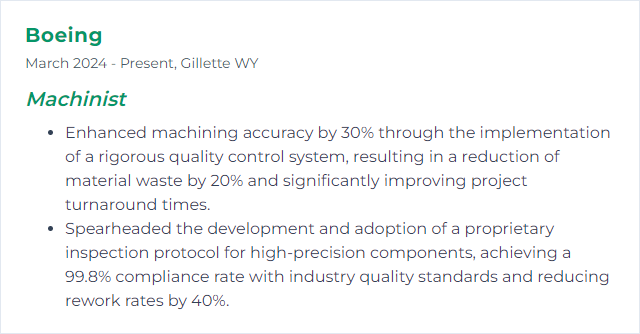
10. Mastercam
Mastercam is a CAM platform for programming CNC machines—turning, milling, and multi-axis—so complex parts can be cut efficiently and accurately.
Why It's Important
Powerful toolpath options, solid verification, and broad machine support help you compress cycle times and boost precision across diverse work.
How to Improve Mastercam Skills
Make the software work for you:
Start with official training: Master the interface, toolpath families, and verification workflows.
Practice with the learning edition: Build repeatable templates for ops, holders, and posts.
Stay updated: New releases often improve roughing and finishing strategies—read the notes and test on sample parts.
Join the community: Forums and user groups reveal settings and post tweaks that save hours.
Watch targeted tutorials: Focus on multiaxis, dynamic milling, probing, and verification best practices.
Customize your workspace: Toolbars, hotkeys, and operation defaults should match your flow.
Understand your machines: Map code output to machine behavior; tune posts and parameters accordingly.
Templates today, throughput tomorrow.
How to Display Mastercam Skills on Your Resume
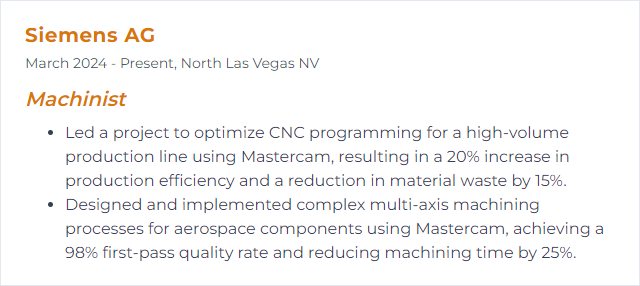
11. SolidWorks
SolidWorks is a CAD system for 2D and 3D modeling. It helps machinists design parts, prep manufacturable features, and hand off clean geometry to CAM.
Why It's Important
Accurate models and drawings reduce ambiguity, cut rework, and speed programming. Less back-and-forth, more chips made right.
How to Improve SolidWorks Skills
Design with machining in mind:
Learn SolidWorks CAM: Bridge design to toolpaths directly and understand feature-based machining.
Master sketching and part modeling: Fully defined sketches, clean feature trees, and stable references prevent rebuild chaos.
Build strong assemblies: Use mates and configurations to check fit, interference, and motion before metal meets tool.
Apply DFM principles: Fillet sizes, tool access, tolerances, and setup-friendly geometry save time on the machine.
Practice on real projects: Reverse engineer shop parts, then improve them for easier machining.
Get certified: Certifications provide structure and a benchmark for your skills.
Tap the community: User forums and user groups surface shortcuts, macros, and workflow tips.
Clean models make clean parts. Simple as that.
How to Display SolidWorks Skills on Your Resume

12. G-Code Interpretation
G-code interpretation is reading and understanding the commands that drive CNC motion—feeds, speeds, arcs, tool changes, work offsets, and more.
Why It's Important
When you understand the code, you can predict machine behavior, spot problems instantly, and tweak programs for safer, faster cuts.
How to Improve G-Code Interpretation Skills
Think like the control:
Learn the language: Modal groups, absolute vs. incremental, plane selection, canned cycles—build a mental model of how the controller “thinks.”
Write and edit: Hand-code small routines. Add subs and macros. You’ll see patterns and pitfalls.
Simulate the path: Visualize moves to catch over-travel, wrong radii, or missed tool length offsets.
Compare controllers: Fanuc-style vs. others can differ on arcs, drilling, and macros. Know your machine’s dialect.
Learn from peers: Communities and shop reviews will expose clever tricks and common gotchas.
Study references: Controller manuals and respected programming handbooks are gold.
Read the code, see the cut. It becomes second nature.
How to Display G-Code Interpretation Skills on Your Resume
